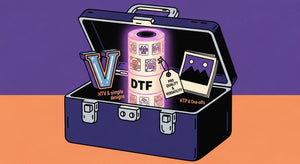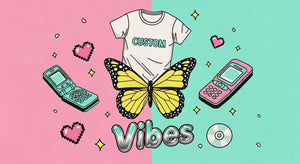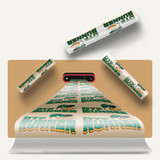Table of Contents
- How Screen Print Transfers Work
- Understanding DTF transfers
- Pros and Cons of Screen Print Transfers
- Pros and Cons of DTF Transfers
- Compare Screen Print Transfers and DTF Transfers
- Case Studies and Real-Life Applications
- Tips for Optimizing Transfer Quality
- Factors to Consider When Choosing Between Screen Print and DTF Transfers
- Future of Heat Transfers
- Conclusion: Choosing the Right Method
The case is the same in custom apparel printing: making the right transfer can make all the difference to help get you where you are trying to go. Highly popular processes include screen print transfers and direct to film transfers. The following post illustrates a comparison between the two. We examine what makes this particular "dtf heat transfers" unique. Here we go through the pros and cons of each, so you can decide what is best for your home.
How Screen Print Transfers Work
Screen printing transfers is the most common method of heat transfer to use a special release paper printed using plastisol inks then once those designs are completed they may be applied to your apparel via press and heat. These are the most durable and vibrant colors around.
Understanding DTF transfers
DTF heat transfers: Direct printing designs directly onto the special film. The design is well then sprayed with powder adhesive while in the printing procedure and cured. The film is then stored, and can be heat-pressed onto the material later. You can print on all other fabrics: Another flexibility from DTF heat transfers is that you can easily use it for printing purposes on other fabrics.
Pros and Cons of Screen Print Transfers
Pros
-
Longevity: Screen print transfers are very long-lasting; this means it can be washed over and over and not fade. There is no limit to the number of washes that the item can last for.
-
Vibrant Colors: The method permits very bright, colourful, and opaque prints, of which this is very good in case of bold designs.
-
Very Cost-Effective for Large Orders: Very affordable when ordered in bulk as the transfer price per print goes down exceptionally.
Cons
-
Not a Lot of Detail: It is not ideal for fine intricate designs that have very small detail.
-
Long Setup Time: Setting up time is quite long, especially for multi-color designs.
-
Fabric Limitations: Best for cotton and polyester blends, not so much on all the fabrics.
Pros and Cons of DTF Transfers
Pros
-
Versatility: Logos are Applicable on T-shirts, Jerseys, Sweatshirts etc of cotton,polyester blended fabric substrates.
-
Detail and Resolution: Images that are high resolution for printing the finest details and gradients.
-
No Minimums: Use on No Minimums or Low quantity order because they have no set up costs.
Cons
-
Durability: DTF heat transfers are really tough however they might not be as durable as screen print transfer.
-
Cost for a Small Run: Generally more expensive per item at the lower end of things than basic screen printing.
-
Special machinery: With this comes the use of special printers and adhesive powders — moderate costs of investment.
Compare Screen Print Transfers and DTF Transfers
When you line up screen print transfers vs. DTF heat transfers, a few obvious factors can be moved into the frame. Durability is something important to consider and screen print transfers certainly are leading in that field. It seems that just color Vibrancy is that one spot where screen print transfers really do have the advantage over another, especially for those super bright and loud designs. DTF heat transfers are multi-purpose as there is a wide range of apparel that can be applied to, even with some very intricate detailed graphics.
Case Studies and Real-Life Applications
Case Study 1: Custom T-Shirts to a Nearby Local Sports Team
Your local sports team asked for custom t-shirts to mark the new season. The screen print transfer process is retired if the image, or sponsor logo in this case, is very bright and colorful. This resulted in T-shirts that would be washed and worn again at the end of each game; yet, the prints remained as dynamic as before.
Case Study 2: Small Business Offering Custom T-Shirts
It is a custom apparel type small business. They want to hand over one-of-a-kinds and small runs as a no big deal up front cost. This led to DTC heat transfers which allowed them to do full, high resolution prints on various fabrics. The added flexibility enabled them to offer for additional products and with more customization features- enabling their work force agility by better adapting to what the customers desired.
Tips for Optimizing Transfer Quality
-
Correct Settings for Your Heat Press: Set proper temperature, pressure, and time on your heat press according to your manufacturer's guidelines for a good quality transfer.
-
Pre-Press Garment: Before prepping the jacket, pre-pressing removes any moisture and wrinkles from the garment assisting in reducing shrinkage. It improves the adhesive property of both screen print and DTF transfers that is largely used for t-shirts printing.
-
Good Quality Materials: The types of transfer paper, inks, and films used will greatly affect how good the final print looks and how well it stands up to being laundered.
-
Conduct Test Prints: By conducting test prints, you will also be able to fine-tune everything, and so avoid expensive job errors that come with large orders or high-complexity designs.
-
Regular Cleaning: Clean your machines regularly and get the service so that the efficiency remains constant in this way you can prevent random defects in the final product.
-
Store Right: Store your transfer films and papers appropriately, and never allow them to degrade by storing them somewhere cold and dry.
Factors to Consider When Choosing Between Screen Print and DTF Transfers
-
Order Size: On high quantity jobs, screenprint transfers are less expensive as they work out to be cheapest per transfer. DTF heat transfer is recommended for little runs and individual pieces of clothes.
-
Type of Fabric: You have to consider what kind of fabric you are going to be printing on. A cotton and polyester blend works best for the screen print transfers. Although DTF heat transfers work with almost all fabric types.
-
Design Complexity: DTF heat transfers are a better option for designs with intricate detailing, gradients or high resolution images. Screen print transfers are great for more simple, but bolder designs.
-
Budget: This is important and you need to know exactly what your budget is when discussing equipment and materials. DTF printing is going to require some specialized tools and materials, which can sometimes add up to being a little expensive when you are first starting out. The screen print transfers are a little labor-intensive on the setup, but it saves money way for orders of 40 pieces or more.
Future of Heat Transfers
This could mean, with this technology advancement, both screenprint and DTF heat transfers are being produced almost certainly. And the development of inks, a better transfer film, heat press will further enhance these processes and make it even more efficient and high-quality. On the same lines, growing need for greener methods as time passes by, giving in terms to ecological transfer papers and inks.
Eco-Friendly Inks
The same manufacturers are phasing in water-based and eco-solvent based inks that largely eliminate the environmental impact of printing, without sacrificing quality. These inks are ideal for screen printing or DTF heat transfer and will be the wave of getting a green consumer.
Automated Systems
The second most significant transformative development in the heat transfer world is automation. Products can be streamlined by automating some systems in screen printing machines, or DTF printers — this saves on labor costs and ensures quality of results. Hence, technology is useful in the case of massiveness requiring efficiency and output increment.
Customization Mug
Let's assume the limitations of what heat transfer can chase isogon. The growth of customized products also always implies that, right? And other than that it will offer improved adhesion for difficult fabrics in the future high resolution prints, and manufacturing speed technology. A companys large or small can offer any number of custom solutions to their products.
Conclusion: Choosing the Right Method
While the screen print transfers may offer a little more diversity in their printing methods, In other words, narrow when it comes to offering bulk orders however firmer and should be able to handle some economy but this can go to waste as easily as detailed fabric compatibility that DTF heat transfer almost has no problem with, but lacks similar strengths in their durability. The latter is more flexible and lowers the overheads, but not printing costs for individual items and likely to last. Now, considering the pros and cons, this is going to help you in determining which one fits your requirements when it comes to custom T-shirt printing.
Ultimately, your choice of screen print transfers and DTF heat transfers will depend on what you need them for, how many garments you're looking to have printed, what type of fabric they are going onto and how complex the design is as well as how much money you have to spend. Naturally, each one has its strengths so just keep them in mind as that will help figure out what performance you should strive for based on customer's apparel use case.
Staying up to date on the latest in your industry can help you stay competitive and able to adapt to changing customer requirements. With the finest new technology and high-grade industry best practice, you will be using screen print transfers or DTF heat transfers, or sometimes even a combination of both whenever it suits you, to deliver your customers top-notch products that are both durable and attractive across all levels.






